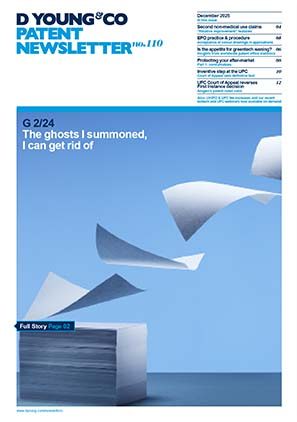Inventive step? How will the UPC decide?
The Unified Patent Court (UPC) is capable of deciding on the validity of those patents subject to its jurisdiction. Inventive step is often a key part of the validity of patents, but how will the UPC decide on the matter of inventive step? Often the assessment of inventive step is borne out through case law, but the UPC has a wealth of potential options to follow, and thus leaves this question somewhat unanswered.
This article looks at approaches adopted in significant territories of unitary patent (UP) member states, as well as the approach used by the Boards of Appeal of the European Patent Office (EPO).
Where might the UPC look to find its approach to assessing inventive step?
Article 24 of the Agreement on a Unified Patent Court sets out the sources of law upon which the court shall base its decisions. Article 24(1)(c) refers to the European Patent Convention (EPC), and thus opens the door to the approach adopted by the Boards of Appeal of the EPO. Article 24(1)(e) refers to national law, and thus potentially allows for the adoption of practices from these territories. Indeed, the UPC is comprised of judges from various participating member states, and according to JUVE Patent, by number, the most represented nationalities of UPC judges are German (33.3%), French (20%), Italian (10.5%), Dutch (8.6%) and Scandinavian (6.7%). It may be reasonable to conclude that some national practices from these territories may find their way into UPC practice.
Overview
Article 56 of the EPC states “An invention shall be considered as involving an inventive step if, having regard to the state of the art, it is not obvious to a person skilled in the art.” Typically, similar provisions exist in the UP member states; such as Section 4 of the German Patents Act or Article L. 611-14 of the French Intellectual Property Code (IPC).
In order to be able to answer whether an invention involves an inventive step one must consider who the person skilled in the art is, and how they would subsequently consider whether something is obvious or not.
The person skilled in the art
As a first step, one must clarify the fictitious person known as the person skilled in the art or “skilled person”. It is the skilled person that makes an assessment as to whether an invention possesses an inventive step.
The EPO considers the person skilled in the art as “a skilled practitioner in the relevant field of technology who is possessed of average knowledge and ability (average skilled person)”. They are aware of common general knowledge and are involved in constant development in the relevant technical field. The skilled person may be considered to seek solutions in other technical fields, if prompted to do so. The skilled person may also be considered to be a group of people, if appropriate.
In the majority of the five territories considered, the skilled person is considered in a similar manner.
In Germany the competent person skilled in the art is often considered a person who is skilled in the field of technology of the invention and usually is assigned to solve the task at hand. In France, however, the skilled person may be considered in a more limited manner. While French courts consider the skilled person to be a person skilled in the technical field that is linked to the invention, case law has dictated that the skilled person’s professional knowledge is limited to their own area of specialisation (see decision 06-19.149 of the Court of Cassation, Commercial Division, dated 26 February 2008). While this does not necessarily exclude the skilled person possessing more general knowledge, it may become prevalent when considering whether a skilled person would consider a particular invention to be obvious.
Approaches for assessing inventive step
The EPO have adopted a three-step problem solution approach, which is summarised in the Guidelines for Examination, Part G-VII, 5:
“In the problem-solution approach, there are three main stages:
(i) determining the “closest prior art”,
(ii) establishing the “objective technical problem” to be solved, and
(iii) considering whether or not the claimed invention, starting from the closest prior art and the objective technical problem, would have been obvious to the skilled person.”
The second step involves identifying distinguishing features between the claimed invention and the closest prior art before defining the objective technical problem in view of the technical effect(s) resulting from the distinguishing features.
The third step involves asking whether there is any teaching in the prior art that would (not simply could, but would) have prompted the skilled person, faced with the objective technical problem, to modify or adapt the closest prior art while taking account of that teaching. This is often referred to as the “could-would” approach, and aims to identify motivation for the skilled person to act in a particular way.
In the five territories mentioned concerning the origins of the UPC judges, the majority of these adopt similar problem-solution approaches. For example, France adopts a broadly similar three-step approach to the EPO’s problem-solution approach, as do Sweden and Italy.
In the Netherlands, while the approach for assessing inventive step is primarily the same as the EPO’s problem-solution approach, other methods are not entirely excluded. Convincing reasons must be given as to why the problem-solution approach is not used in a particular case. However, perhaps unlike other jurisdictions, it has often been considered that combinations of more than two prior art documents may itself be an indication of inventiveness.
The assessment of inventive step in Germany is somewhat different to the EPO’s problem-solution approach, although it has been remarked that the same conclusions are often reached.
Unlike the EPO’s problem-solution approach there is no determination of the “closest prior art”, but rather the starting point for inventive step is any reference the skilled person would realistically find without knowledge of the invention; however, the selection of a particular reference should be justified.
Some commentators have remarked that to determine the closest prior art necessarily involves knowing the invention, which may be considered to introduce hindsight into any inventive step analysis. Equally, in the decision of the FCJ, X ZR 41/13, “Quetiapin”, it was specified that “the technical problem must be stated in such general and neutral terms that the question of which ideas were suggested to the expert by the state of the art with respect to this problem arises solely during the assessment of inventive step”, as opposed to necessarily considering the problem in view of the differences between the closest prior art and the selected reference.
As a brief note, in some instances, secondary indicators may be used to support or show the presence of an inventive step; such unexpected technical effect, a long-felt want, or commercial success (coupled with a long-felt want). Similar secondary indicators are considered in many of the jurisdictions mentioned.
An early insight?
A decision of the Court of First Instance of the UPC (Munich Local Division) (procedure number UPC CFI 2/2023), in respect of interim measures concerning unified patent EP 4108782, has recently published.
The decision considered, among other factors, whether the claims of EP 4108782 are novel or inventive, as alleged by the respondent. The decision states that “An important criterion in choosing the most promising starting point is the similarity of the technical task” noting that “aspects such as the designation of the subject-matter of the invention, the formulation of the original task and intended use as well as the effects to be achieved should generally be given more weight than a maximum number of identical technical features”. This statement draws some parallels with the approach adopted by the European Board of Appeal in T 0606/89; “…the claimed invention should be compared with the art concerned with a similar use which requires the minimum of structural and functional modifications”, which may be suggestive of a problem-solution type assessment to inventive step.
While an assessment of inventive step in the this decision has only been taken to the extent necessary, and thus does not consider any particular methodology for assessing inventive step, note that the court has taken quite a strict approach to dismissing references as suitable starting points. For instance, the court dismisses references on the basis that “the court cannot see that this document suggests the invention according to the patent” or “in view of the task underlying the patent in suit”, seemingly placing a strong emphasis on the similarity of technical tasks between the references and patent in suit.
Could this be an early indication as to how the UPC will assess inventive step, and particularly in relation to selecting (or dismissing) closest prior art documents?
We note that there is a parallel pending European opposition against EP 4108782 filed by the respondents in the above matter, which seemingly uses similar documents as starting points for the assessment of inventive step. The European opposition proceedings are at an early stage, but we await further developments with interest, particularly with regard to whether the EPO will come to the same or different conclusion as the preliminary view from the UPC.
Conclusion
Despite a potential insight offered by the decision of the Court of First Instance, precisely how and under which criteria and methodologies the UPC will assess inventive step remains to be seen.
In practical terms, when validity is at issue before a UPC court for example, it may be prudent to bear in mind the different approaches to inventive step, at least in the key UP member states, and build an inventive step position which takes account of the leading case law in the member states of the UPC, as well as before the EPO Boards of Appeal.
Useful links
- EPO: Agreement on a Unified Patent Court, Part 1, Chapter V, Article 24: dycip.com/epo-article-24
- UPC judges: a complete overview, JUVE Patent, 16 August 2023: dycip.com/upcjudges
- EPO: European Patent Convention, Part II, Chapter I, Article 56: Inventive step: dycip.com/inventive-step-article-56
- EPO: Guidelines for Examination, Part G: Patentability, Chapter VII: Inventive step, 3. Person skilled in the art: dycip.com/epoguidelines-personskilled
- EPO: Guidelines for Examination, Part G: Patentability, Chapter VII: Inventive Step, 5. Problem-solution approach: dycip.com/epoguidelines-problem-solution
- BGH, Urteil vom 13. 1. 2015 – X ZR 41/13, “Quetiapin”: dycip.com/fcj-XZR41-13-quetiapin
- Decision 06-19.149, Court of Cassation, Commercial Division, 26 February 2008: dycip.com/court-of-cassation-06-19-149
- UPC CFI 2/2023, Court of First Instance – Munich, Germany (local division), UPC, 19 September 2023: dycip.com/upc-cfi-2-2023
- T 0606/89, EPO, 18 September 1990: dycip.com/epo-t-0606-89
- Study on inventive step, standing committee on the law of patents (twenty-second session), WIPO, 27-31 July 2023: dycip.com/wipo-inventivestep


